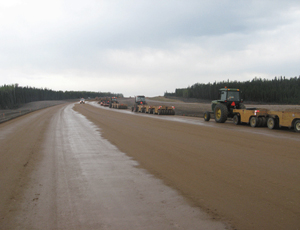

Alberta's Ministry of Transportation wants to expedite twinning of the 155-mile Highway 63 leading to Alberta’s busy oil-sands region. Officials vow that the remainder of the $1-billion road project, whose northern two-thirds run through government-owned land, will be completed in eight years rather than 11, despite the challenges posed by the weather-fussy region north of Edmonton.
Twinning started in 2007 with the first 10-mile section, which was completed by Thompson Bros. LP, Spruce Grove, Alberta. Originally slated to take more than 11 years, the project is being condensed into an eight-year process, says Landon Reppert, regional director for Alberta Transportation. Vancouver-based Ledcor now has crews working on a 22-mile stretch, scheduled for a fall 2013 completion.
But the sheer volume of road to be built isn’t the only obstacle in the process. Environmental difficulties, utility challenges and various types of traffic on a highway known for deadly head-on collisions—a fact that has motivated politicians to speed up the process—are also factors. Furthermore, the project has faced a variety of lawsuits.
To protect line painting and accommodate trucks with oversize loads heading to the oil sands, the new roadway includes one lane that is over 14 ft wide, instead of the standard width of 12 ft, Reppert says. On the government-owned portion, the space between the northbound and southbound lanes has expanded by about 50 ft, to 180 ft wide, allowing drivers to keep their high beams on and giving big rigs space to pull off the highway.
Getting the asphalt laid has been costly and time-consuming, largely because of the area’s propensity for muskeg soil, an acidic, clumping mix of decomposing plant matter. “It isn’t a suitable material for building road,” Reppert says. The muskeg, anywhere from six inches to six feet deep, must be fully removed because it retains moisture and freezes, causing significant settling. Crews fill the voids with clay or silt sands. So far, the current 22-mile stretch has required a ton of fill.
Fred Podovinnikoff, Thompson Bros. project manager, says the twinning Highway 63 work is “tough building,” especially with the extremely wet, murky ground conditions. “It is not like building road in the [Canadian] south, where you have good [material] and dry conditions,” he says. “But it is doable.”
The engineers must deal with the complex tasks of tying into existing roads and using culverts to cross streams and rivers, Podovinnikoff adds.
Most utility pipes are placed in a designated corridor that crosses under the existing highway at least six times. “These aren’t little two-inch plastic lines," Reppert says. "The welded steel pipes are up to one meter in diameter.” Some of the older pipes need to be protected with a special casing or, in some cases, a concrete slab.
Harsh, snowy winters, restrictions on tree removal, and nesting birds and caribou limit the work to June until mid-October. Nevertheless, Ledcor’s 22-mile stretch is expected to wrap up in fall 2013, and a southern section will be readied for bidding late this year. Over 50% of the project is expected to be completed in the next three years.


Post a comment to this article
Report Abusive Comment